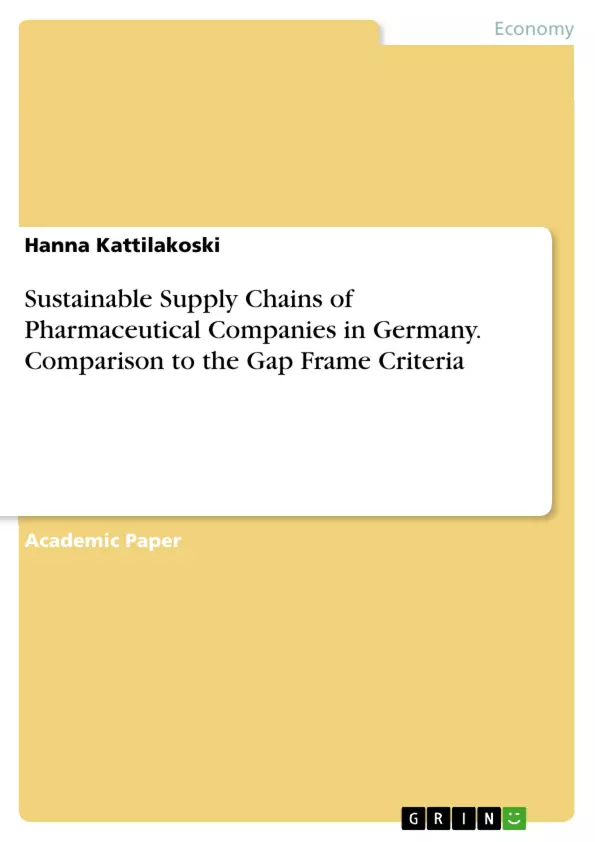The purpose of this paper is to investigate the pharmaceutical industry in terms of sustainable supply chains and comparing this to the Gap Frame Framework. Two companies, Bayer and Roche, will be analyzed to provide a look into current practice.
The Gap Frame is a framework that translates the Sustainable Development Goals (SDG) into nationally relevant issues and indicators for business. The aim of this framework is to aid companies in shifting their behavior and strategic perspectives by showing both the inside-out and outside-in perspectives of environmental challenges a country is facing.
By using the Gap Frame from an outside-in perspective, businesses can address the challenges highlighted by the circle model and use an integrative approach to better align their operations in order to reach the SDGs. The four sustainability dimensions in the circle model are Planet, Society, Economy and Governance. The focus of this research will be on the economy dimension, which includes several issues: Innovation, Employment, Resource Use, Sustainable Production, Sustainable Consumption.
Inhaltsverzeichnis (Table of Contents)
- Introduction
- Gap Frame Focus
- Sustainable Development Goal Focus
- Geographic Focus
- Assessing the Gap Frame Criteria
- Sustainable Production
- Sustainable Production Indicators
- Sustainable Production Criticism
- Sustainable Consumption
- Sustainable Consumption Indicators
- Sustainable Consumption Criticism
- Resource Use
- Resource Use Indicators
- Resource Use Criticism
- GRI G4 Criteria
- Sustainability through industry wide associations
- German Industry-wide Initiatives
- Global Initiatives
- Sustainability in the Supply Chain
- Drug Discovery and Development
- Drug Production
- Drug Delivery and Dispensing
- Challenges within Germany
- Company Case Studies
- Bayer
- Bayer commitment to Sustainability
- Sustainability Initiatives at Bayer
- Bayer and the Gap Frame Criteria
- Roche
- Roche Sustainability Overview
- Sustainability Initiatives at Roche
- Roche and Gap Frame Criteria
- Meeting SDG based on GAP Frame Criteria
- Focus on Specific SDGs
- Use Gap Frame Indicators as Guidelines
- Join Industry Wide Organizations
- Develop Company Targets and Goals
- Overcoming the challenges in Germany
Zielsetzung und Themenschwerpunkte (Objectives and Key Themes)
This paper aims to examine the pharmaceutical industry in terms of sustainable supply chains and compare this to the Gap Frame Framework. The analysis will focus on two prominent companies, Bayer and Roche, to provide insights into current practices within the industry.
- Sustainable Production
- Sustainable Consumption
- Resource Use
- Gap Frame Framework
- Sustainable Supply Chain Management
Zusammenfassung der Kapitel (Chapter Summaries)
The paper begins by introducing the Gap Frame Framework and its relevance to sustainable development goals, focusing specifically on the economic dimension, which includes sustainable production, consumption, and resource use. It then delves into the Sustainable Development Goal 12: Responsible Consumption and Production, highlighting its connection to the Gap Frame areas of focus. Chapter 1 also establishes Germany as the geographic focus, emphasizing its significance as a major player in the global pharmaceutical industry.
Chapter 2 provides a detailed assessment of the Gap Frame criteria, analyzing each issue of focus – sustainable production, sustainable consumption, and resource use – by exploring indicators and their relevance to businesses. It also explores industry-wide associations and their role in promoting sustainable practices within the pharmaceutical sector.
Chapter 3 delves into the specifics of sustainable supply chain management within the pharmaceutical industry, examining different stages – drug discovery and development, drug production, and drug delivery and dispensing. The chapter then explores the unique challenges faced by the pharmaceutical industry in Germany in achieving sustainable practices.
Chapter 4 focuses on company case studies, analyzing the sustainability commitments, initiatives, and practices of Bayer and Roche. The chapter also examines how these companies align their operations with the Gap Frame criteria.
Chapter 5 explores strategies for achieving sustainable development goals based on the Gap Frame criteria, including focusing on specific SDGs, utilizing Gap Frame indicators as guidelines, joining industry-wide organizations, and developing company-specific targets and goals.
Schlüsselwörter (Keywords)
This research focuses on the sustainable supply chains of pharmaceutical companies in Germany. Key themes include sustainable production, sustainable consumption, resource use, the Gap Frame Framework, sustainable development goals, and company case studies of Bayer and Roche.
- Quote paper
- Hanna Kattilakoski (Author), 2017, Sustainable Supply Chains of Pharmaceutical Companies in Germany. Comparison to the Gap Frame Criteria, Munich, GRIN Verlag, https://www.grin.com/document/594219



